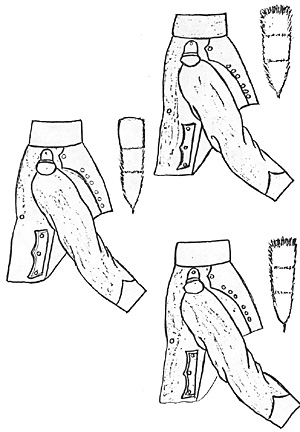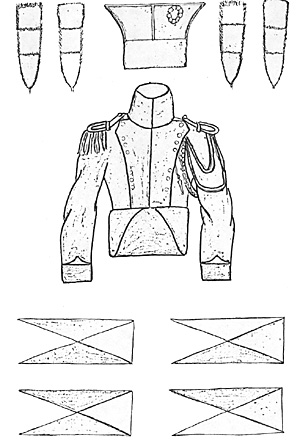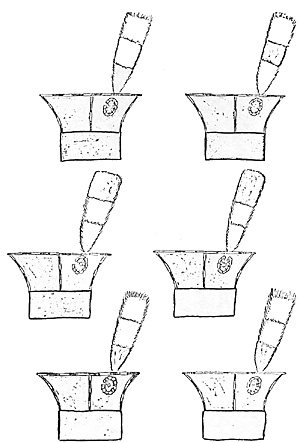 The legion continued to grow in size and on the 2nd of June it was reorganized into two legions. At the same time the battalions were also reorganized, each battalion now had one company of Grenadiers, one company of Chasseurs and eight companies of Fusiliers. The Artillery was assigned to the II legion. Each legion was comprised of 3 battalions of 10 companies, each of 125 men and there were 3 companies of Artillery. I legion was under the command of General Kniaziewecz, II legion was under the commanded by General Wielhorski, and the Artillery was commanded by Chief of battalion Axamitowski while General Dombrowski remained the commanderin-Chief of the entire Polish corps.
The legion continued to grow in size and on the 2nd of June it was reorganized into two legions. At the same time the battalions were also reorganized, each battalion now had one company of Grenadiers, one company of Chasseurs and eight companies of Fusiliers. The Artillery was assigned to the II legion. Each legion was comprised of 3 battalions of 10 companies, each of 125 men and there were 3 companies of Artillery. I legion was under the command of General Kniaziewecz, II legion was under the commanded by General Wielhorski, and the Artillery was commanded by Chief of battalion Axamitowski while General Dombrowski remained the commanderin-Chief of the entire Polish corps.
The 1st battalion of the 2nd legion wore black facings. Those of the 2nd battalion were blue. For the 3rd battalion, the facings were of pink.
The plumes for the 2nd legion were the same as those used in the 1st legion.
French regulations were in use for garrison duty but drill and disipline were according to the old Polish regulations except for corporal punishment which was forbidden as it was in the French army of that day.
With reorganization of the legion the uniforms also underwent change in facing colors and plumes. Each battalion in each of the legions was given its own distinctive color. The colors of the old legion, amaranth, yellow and green, were kept by the battalions of I legion. Thus, in I legion, the 1st battalion wore collar, cuffs, turnbacks, facings, and piping of amaranth with the plume of blue, red, and white (from top to bottom). In the 2nd battalion these were in yellow with the plume red, white, and blue. Green was used by the 3rd battalion of I legion and their plume was white, blue, and red.
New colors were given to the three battalions of II legion however the plumes were the same as those used in I legion. In II legion the 1st battalion was given black as their distinguishing color, blue was given to the 2nd battalion for their color (this is usually shown as a somewhat lighter blue than the dark blue of the uniform), and pink was the identifying color of the 3rd battalion.
In both of the legions red plumes were worn by Grenadiers and green plumes were worn by Chasseurs. Therefore the tricolor plume was worn only by the Fusiliers.
Staff officers and generals wore crimson collar, cuffs, lapels, turnbacks and pipings. The plume for staff officers was divided into three vertical sections of (left to right) red, white, and blue.
Employment was soon found for the new Polish corps. In July of 1797 the insurrection of Reggio was suppressed, it took only a week. It was here that the patriot Joseph Wybicki composed his mazurka which became the song of the legions and in 1926 the anthem of Poland. It began "Poland has not yet perished."
The Poles also took part in the French occupation of Rome with General Kniaziewicz arriving there with his 1st battalion and the artillery of 3 May 1798, the anniversary of the founding of the Polish constitution in 179
Sometime during 1798 another change was made in the uniform. For the first time we see the czapka without a turban of black lamb. Mr. Pachonski, who' painting are the most accurate describes them as being of green cloth with dark red and white piping in all seams and the turban is now of cloth in t1 colors of the battalions. The visor may have been added at this time although it is not known for certain.
 Czapka and kurtka of cavalry 1799. Left are plumes of 1st and 2nd co. of the 1st sqdn with lance pennons below. On right are plumes and pennons of the 1st and 2nd co. of the 2nd sqdn.
Czapka and kurtka of cavalry 1799. Left are plumes of 1st and 2nd co. of the 1st sqdn with lance pennons below. On right are plumes and pennons of the 1st and 2nd co. of the 2nd sqdn.
While in Rome, the counsil of Rome presented to General Dombrowski the Mahomet flag which lead been given to the Vatican by Jan Sobieski after the battle of Vienna in 1683. The flag along with the sword of Jan Sobiesk had been kept in the church of Notre Dame de Lorette. The standard went with the headquarters while the sword was sent to Paris to be presented to Tadeusz Kosciuszko.
In November the Roman Republic was invaded by a Neapolitan army under the command of the Austrian General Karl Mack. It was their intent to drive out the French and on the 29th the city of Rome was captured.
The Polish and French forces under the command of General Championnet retreated across the Tiber arid established a headquarters at Civita-Castellan. In the absence of General Dombrowski, General Kniaziewecz was in command of the Polish corps which formed the left wing.
On the 1st of December the Poles and French again crossed the Tiber and they were successful in forcing the Neapolitan army into retreating back to their fortified camp at Magliano.
On December 4 the Poles fought at the battle of Civita-Castellana, the Neapolitans were forced to retreat in grey disorder and the Poles distinguised themselves and-were mentioned in the order of the day which reads in part:
- "The army was given news that the Neapolitan column, approximately 5,000 men attacked and took Magliano. General McDonald gave General Kniaziewecz the order to attack Magliano with 300 of his legion. After a severe exchange of fire they forced the enemy to retreat, killing and wounding many. They took all the equipment of the camp, 1 officer, several of the soldiers, the pharmacy and all the baggage. It is to be noted that the corp of 300 men won the battle repulsing 5,000."
- Signed
LEOPOALD BERTHIER
General Championnet followed the retreat of the army towards Naples and captured many more prisoners, Gaete was also taken and the 1st battalion of the I Legion was established there in garrison.
General Kniaziewecz continued to march, took Traetta on the 1st of Jan. 179 and captured the royal breeding stock of Mondragione.
The Poles were very pleased with this new and rich prize and it created ideas. Captain Eli Tremo considered the idea of a corps of Polish calvary for the legion, utilizing these horses, others captured at Gaete and a large stock of arms and equipment which had also been taken at Gaete.
The plan was immediately approved by the Polish generals as well as General Championnet and it was actively persued. Karwowski was to be the colonel and Eli Tremo along with Biernack and Josielowicz named to the posts of Chied of Squadron. Formation of the cavalry did not delay the march of the Poles or prevent them-from taking part in the surrounding of Capua which was given to France in the armistace of 11 January.
 Around 1798 the czapkas od both legions were changed. Mr. Pchonski painted them green with piping in red and white and lower part, or turban in the color of thebattalion. The three czapkas on left are illustrated in this manner: green with turbans of dark red, green, and yellow for the 1st legion. On right, turbans of black, blue, and pink for battalions of the 2nd legion.
Around 1798 the czapkas od both legions were changed. Mr. Pchonski painted them green with piping in red and white and lower part, or turban in the color of thebattalion. The three czapkas on left are illustrated in this manner: green with turbans of dark red, green, and yellow for the 1st legion. On right, turbans of black, blue, and pink for battalions of the 2nd legion.
It is necessary to point out that the organization of the cavalry was never really completed nor was this a very successful unit. It sustained heavy losses during the remainder of the campaigns, especially during the retreat of 1 March 1800. It was finally decided that there would be no cavalry attached to the corps and that which remained was sent to Metz to reinforce the cavalry of the Legion of the Rhine which was created by decree of 13 October 1800.
The uniform of the cavalry, like that of the infantry, was of dark blue and very similar in style. The czapka was of crimson with a black turban and white piping. It may or may not have a visor. Colonel Gembarzewski described and illustrated them as tricolored of red, white, and blue. For the 1st company of the 1st squadron they were (top to bottom) blue, white, and red; in the second company they were red, white and blue. In the 1st company of the 2nd squadron they were white, blue, and red; and in the 2nd company red, blue, and white.
Collar, square cut cuffs, lapels, turnbacks and piping of the kurtka are of crimson. The buttons are of silver or of white metal, epaulettes are white or silver for officers and on the left shoulder an aiguillette of white or silver was worn. The cartouche is worn suspended from a white belt which is worn over the left shoulder and a white belt with silver buckle encircles the waist.
Breeches are of dark blue, tight fitting and worn inside short black boots. The outside seam of each leg is decorated with a single crimson stripe and on each thigh there is a spear head design. The galon of this may also have been in crimson.
Each company of the 2 squadrons were also identified by the swallow-tailed pennon on the lance. These were of a tricolor design with the location of the various colors the key to identification. The colors separated the pennons into three separate triangular areas. For the 1st company of the 1st squadron the upper triangle was blue, that nearest the lance was white and the one on the bottom was red. In the 2nd company they were red, white and blue. The two companies of the 2nd squadron had white uppermost, blue next to the lance and red on the bottom for the 1st company and red on the top, blue near the lance and white at the bottom for the second company. The lance pennons match exactly the plumes of the czapka with the color next to the lance representing the color in the center of the plume.
As illustrated by Colonel Gembarzewski, the horse furniture is typically Polish. The shabraque is of white lamb with a crimson saw tooth edge. It is identical to those used by the French Chevau-Leger-Lancers of the line.
Back to Empire, Eagles, & Lions Table of Contents Vol. 1 No. 21
Back to EEL List of Issues
Back to MagWeb Master Magazine List
© Copyright 1978 by Jean Lochet
This article appears in MagWeb.com (Magazine Web) on the Internet World Wide Web.
Other articles from military history and related magazines are available at http://www.magweb.com
